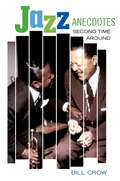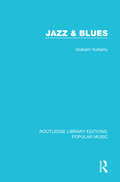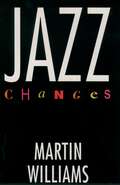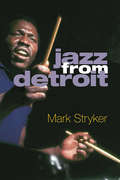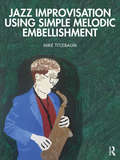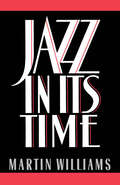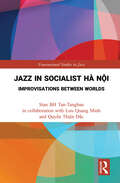- Table View
- List View
Jazz and Totalitarianism
by Bruce JohnsonJazz and Totalitarianism examines jazz in a range of regimes that in significant ways may be described as totalitarian, historically covering the period from the Franco regime in Spain beginning in the 1930s to present day Iran and China. The book presents an overview of the two central terms and their development since their contemporaneous appearance in cultural and historiographical discourses in the early twentieth century, comprising fifteen essays written by specialists on particular regimes situated in a wide variety of time periods and places. Interdisciplinary in nature, this compelling work will appeal to students from Music and Jazz Studies to Political Science, Sociology, and Cultural Theory.
Jazz and Totalitarianism
by Bruce JohnsonJazz and Totalitarianism examines jazz in a range of regimes that in significant ways may be described as totalitarian, historically covering the period from the Franco regime in Spain beginning in the 1930s to present day Iran and China. The book presents an overview of the two central terms and their development since their contemporaneous appearance in cultural and historiographical discourses in the early twentieth century, comprising fifteen essays written by specialists on particular regimes situated in a wide variety of time periods and places. Interdisciplinary in nature, this compelling work will appeal to students from Music and Jazz Studies to Political Science, Sociology, and Cultural Theory.
Jazz Anecdotes: Second Time Around
by Bill CrowWhen jazz musicians get together, they often delight one another with stories about the great, or merely remarkable, players and singers they've worked with. One good story leads to another until someone says, "Somebody ought to wrie these down!" With Jazz Anecdotes, somebody finally has. Drawing on a rich verbal tradition, bassist and jazz writer Bill Crow has culled stories from a wide variety of sources, including interviews, biographies and a remarkable oral history collection, which resides at the Institute of Jazz Studies at Rutgers University, to paint fascinating and very human portraits of jazz musicians. Organized around general topics--teaching and learning, life on the road, prejudice and discrimination, and the importance of a good nickname--Jazz Anecdotes shows the jazz world as it really is. In this fully updated edition, which contains over 150 new anecdotes and new topics like Hiring and Firing, Crow regales us with new stories of such jazz greats as Benny Goodman, Chet Baker, Ravi Coltrane, Buddy Rich and Paul Desmond. He offers extended sections on old favorites--Louis Armstrong, Duke Ellington, Coleman Hawkins and Lester Young, and the fabulous Eddie Condon, who seems to have lived his entire life with the anecdotist in mind. With its unique blend of sparkling dialogue and historical and social insight, Jazz Anecdotes will delight anyone who loves a good story. It offers a fresh perspective on the joys and hardships of a musician's life as well as a rare glimpse of the personalities who created America's most distinctive music.
Jazz Anecdotes: Second Time Around
by Bill CrowWhen jazz musicians get together, they often delight one another with stories about the great, or merely remarkable, players and singers they've worked with. One good story leads to another until someone says, "Somebody ought to wrie these down!" With Jazz Anecdotes, somebody finally has. Drawing on a rich verbal tradition, bassist and jazz writer Bill Crow has culled stories from a wide variety of sources, including interviews, biographies and a remarkable oral history collection, which resides at the Institute of Jazz Studies at Rutgers University, to paint fascinating and very human portraits of jazz musicians. Organized around general topics--teaching and learning, life on the road, prejudice and discrimination, and the importance of a good nickname--Jazz Anecdotes shows the jazz world as it really is. In this fully updated edition, which contains over 150 new anecdotes and new topics like Hiring and Firing, Crow regales us with new stories of such jazz greats as Benny Goodman, Chet Baker, Ravi Coltrane, Buddy Rich and Paul Desmond. He offers extended sections on old favorites--Louis Armstrong, Duke Ellington, Coleman Hawkins and Lester Young, and the fabulous Eddie Condon, who seems to have lived his entire life with the anecdotist in mind. With its unique blend of sparkling dialogue and historical and social insight, Jazz Anecdotes will delight anyone who loves a good story. It offers a fresh perspective on the joys and hardships of a musician's life as well as a rare glimpse of the personalities who created America's most distinctive music.
Jazz as Visual Language: Film, Television and the Dissonant Image
by Nicolas PillaiThis book provides a timely analysis of the relationship between jazz and recording and broadcast technologies in the early twentieth century. Jazz histories have traditionally privileged qualities such as authenticity, naturalness and spontaneity, but to do so overlooks jazz's status as a modernist, mechanised art form that evolved alongside the moving image and visual cultures. Jazz as Visual Language shows that the moving image is crucial to our understanding of what the materiality of jazz really is. Focusing on Len Lye's direct animation, Gjon Mili's experimental footage of musicians performing and the BBC's Jazz 625 series, this book places emphasis on film and television that conveys the 'sound of surprise' through formal innovation, rather than narrative structure. Nicolas Pillai seeks to refine a critical vocabulary of jazz and visual culture whilst arguing that jazz was never just a new sound; it was also a new way of seeing the world.
Jazz as Visual Language: Film, Television and the Dissonant Image (International Library of the Moving Image (PDF))
by Nicolas PillaiThe new phenomenon of jazz music took the world by storm in the 1920s and 1930s. Yet from the outset jazz was much more than just a musical genre: it has always drawn upon and interacted with visual media. This book provides a timely analysis and history of jazz onscreen, by examining works in which the artistry and intelligence of great musicians is expressed through experimental and innovative image-making.
Jazz & Blues (Routledge Library Editions: Popular Music)
by Graham VulliamyThis book, first published in 1982, shows that jazz and blues are music forms that are about individualism, experiment, expression and feeling. From their origin in the work songs and spirituals of America’s southern slaves, through to their adaptation to the urban adaptation to the urban environment in Chicago and New Orleans, the author details the social and economic background that saw the birth of the blues and jazz, and introduces and appraises their leading exponents. He shows how African rhythms were combined with an American musical tradition to produce a distinctive style which was to revitalise Western music.
Jazz & Blues (Routledge Library Editions: Popular Music)
by Graham VulliamyThis book, first published in 1982, shows that jazz and blues are music forms that are about individualism, experiment, expression and feeling. From their origin in the work songs and spirituals of America’s southern slaves, through to their adaptation to the urban adaptation to the urban environment in Chicago and New Orleans, the author details the social and economic background that saw the birth of the blues and jazz, and introduces and appraises their leading exponents. He shows how African rhythms were combined with an American musical tradition to produce a distinctive style which was to revitalise Western music.
Jazz Changes
by Martin WilliamsJazz Changes is the late Martin Williams's third and perhaps best collection of jazz portraits, interviews, narrative accounts of recording sessions, rehearsals, and performances, important liner notes, and far reaching discussions of musicians and their music. The collection includes thirty years of Williams's finest pieces taking readers on an engaging tour of the changing jazz world. There are appreciation-profiles and comments on such performers as Ross Russell--about the noted Dial Record sessions with Charlie Parker--and greats like John Coltrane, Billie Holiday, Jelly Roll Morton, Ornette Coleman, Dinah Washington, and Thelonious Monk. Williams also offers parodies of how jazz critics in 1965 might have assessed the Beatles, and reflections on the Ellington era. He concludes with an elegant plea for critics to pay attention to jazz history, always exhibiting his keen mind and gifted pen.
Jazz Diaspora: Music and Globalism
by Bruce JohnsonJazz Diaspora: Music and Globalism is about the international diaspora of jazz, well underway within a year of the first jazz recordings in 1917. This book studies the processes of the global jazz diaspora and its implications for jazz historiography in general, arguing for its relevance to the fields of sonic studies and cognitive theory. Until the late twentieth century, the historiography and analysis of jazz were centred on the US to the almost complete exclusion of any other region. The driving premise of this book is that jazz was not ‘invented’ and then exported: it was invented in the process of being disseminated. Jazz Diaspora is a sustained argument for an alternative historiography, based on a shift from a US-centric to a diasporic perspective on the music. The rationale is double-edged. It appears that most of the world’s jazz is experienced (performed and consumed) in diasporic sites – that is, outside its agreed geographical point of origin – and to ignore diasporic jazz is thus to ignore most jazz activity. It is also widely felt that the balance has shifted, as jazz in its homeland has become increasingly conservative. There has been an assumption that only the ‘authentic’ version of the music--as represented in its country of origin--was of aesthetic and historical interest in the jazz narrative; that the forms that emerged in other countries were simply rather pallid and enervated echoes of the ‘real thing’. This has been accompanied by challenges to the criterion of place- and race-based authenticity as a way of assessing the value of popular music forms in general. As the prototype for the globalisation of popular music, diasporic jazz provides a richly instructive template for the study of the history of modernity as played out musically.
Jazz Diaspora: Music and Globalism
by Bruce JohnsonJazz Diaspora: Music and Globalism is about the international diaspora of jazz, well underway within a year of the first jazz recordings in 1917. This book studies the processes of the global jazz diaspora and its implications for jazz historiography in general, arguing for its relevance to the fields of sonic studies and cognitive theory. Until the late twentieth century, the historiography and analysis of jazz were centred on the US to the almost complete exclusion of any other region. The driving premise of this book is that jazz was not ‘invented’ and then exported: it was invented in the process of being disseminated. Jazz Diaspora is a sustained argument for an alternative historiography, based on a shift from a US-centric to a diasporic perspective on the music. The rationale is double-edged. It appears that most of the world’s jazz is experienced (performed and consumed) in diasporic sites – that is, outside its agreed geographical point of origin – and to ignore diasporic jazz is thus to ignore most jazz activity. It is also widely felt that the balance has shifted, as jazz in its homeland has become increasingly conservative. There has been an assumption that only the ‘authentic’ version of the music--as represented in its country of origin--was of aesthetic and historical interest in the jazz narrative; that the forms that emerged in other countries were simply rather pallid and enervated echoes of the ‘real thing’. This has been accompanied by challenges to the criterion of place- and race-based authenticity as a way of assessing the value of popular music forms in general. As the prototype for the globalisation of popular music, diasporic jazz provides a richly instructive template for the study of the history of modernity as played out musically.
Jazz from Detroit
by Mark StrykerJazz from Detroit explores the city’s pivotal role in shaping the course of modern and contemporary jazz. With more than two dozen in-depth profiles of remarkable Detroit-bred musicians, complemented by a generous selection of photographs, Mark Stryker makes Detroit jazz come alive as he draws out significant connections between the players, eras, styles, and Detroit’s distinctive history. Stryker’s story starts in the 1940s and ’50s, when the auto industry created a thriving black working and middle class in Detroit that supported a vibrant nightlife, and exceptional public school music programs and mentors in the community like pianist Barry Harris transformed the city into a jazz juggernaut. This golden age nurtured many legendary musicians—Hank, Thad, and Elvin Jones, Gerald Wilson, Milt Jackson, Yusef Lateef, Donald Byrd, Tommy Flanagan, Kenny Burrell, Ron Carter, Joe Henderson, and others. As the city’s fortunes change, Stryker turns his spotlight toward often overlooked but prescient musician-run cooperatives and self-determination groups of the 1960s and ’70s, such as the Strata Corporation and Tribe. In more recent decades, the city’s culture of mentorship, embodied by trumpeter and teacher Marcus Belgrave, ensured that Detroit continued to incubate world-class talent; Belgrave protégés like Geri Allen, Kenny Garrett, Robert Hurst, Regina Carter, Gerald Cleaver, and Karriem Riggins helped define contemporary jazz. The resilience of Detroit’s jazz tradition provides a powerful symbol of the city’s lasting cultural influence. Stryker’s 21 years as an arts reporter and critic at the Detroit Free Press are evident in his vivid storytelling and insightful criticism. Jazz from Detroit will appeal to jazz aficionados, casual fans, and anyone interested in the vibrant and complex history of cultural life in Detroit.
Jazz Improvisation Using Simple Melodic Embellishment
by Mike TitlebaumJazz Improvisation Using Simple Melodic Embellishment teaches fundamental concepts of jazz improvisation, highlighting the development of performance skills through embellishment techniques. Written with the college-level course in mind, this introductory textbook is both practical and comprehensive, ideal for the aspiring improviser, focused not on scales and chords but melodic embellishment. It assumes some basic theoretical knowledge and level of musicianship while introducing multiple techniques, mindful that improvisation is a learned skill as dependent on hard work and organized practice as it is on innate talent. This jargon-free textbook can be used in both self-guided study and as a course book, fortified by an array of interactive exercises and activities: musical examples performance exercises written assignments practice grids resources for advanced study and more! Nearly all musical exercises—presented throughout the text in concert pitch and transposed in the appendices for E-flat, B-flat, and bass clef instruments—are accompanied by backing audio tracks, available for download via the Routledge catalog page along with supplemental instructor resources such as a sample syllabus, PDFs of common transpositions, and tutorials for gear set-ups. With music-making at its core, Jazz Improvisation Using Simple Melodic Embellishment implores readers to grab their instruments and play, providing musicians with the simple melodic tools they need to "jazz it up."
Jazz Improvisation Using Simple Melodic Embellishment
by Mike TitlebaumJazz Improvisation Using Simple Melodic Embellishment teaches fundamental concepts of jazz improvisation, highlighting the development of performance skills through embellishment techniques. Written with the college-level course in mind, this introductory textbook is both practical and comprehensive, ideal for the aspiring improviser, focused not on scales and chords but melodic embellishment. It assumes some basic theoretical knowledge and level of musicianship while introducing multiple techniques, mindful that improvisation is a learned skill as dependent on hard work and organized practice as it is on innate talent. This jargon-free textbook can be used in both self-guided study and as a course book, fortified by an array of interactive exercises and activities: musical examples performance exercises written assignments practice grids resources for advanced study and more! Nearly all musical exercises—presented throughout the text in concert pitch and transposed in the appendices for E-flat, B-flat, and bass clef instruments—are accompanied by backing audio tracks, available for download via the Routledge catalog page along with supplemental instructor resources such as a sample syllabus, PDFs of common transpositions, and tutorials for gear set-ups. With music-making at its core, Jazz Improvisation Using Simple Melodic Embellishment implores readers to grab their instruments and play, providing musicians with the simple melodic tools they need to "jazz it up."
Jazz in Contemporary China: Shifting Sounds, Rising Scenes
by Adiel PortugaliBased on interviews, conversations, and observations drawn from extensive field research, Jazz in Contemporary China: Shifting Sounds, Rising Scenes explores the current developments and conditions of Chinese jazz. Negotiating socio-political, cultural, and spatial phenomena, the author provides unique insights for understanding China’s modern history through its happenings in jazz, unveiling an insider’s look at the musicians and individuals who populate and propel these scenes. This first-hand perspective illuminates how jazz generates and disseminates practices of creativity and individuality in twenty-first-century China.
Jazz in Contemporary China: Shifting Sounds, Rising Scenes
by Adiel PortugaliBased on interviews, conversations, and observations drawn from extensive field research, Jazz in Contemporary China: Shifting Sounds, Rising Scenes explores the current developments and conditions of Chinese jazz. Negotiating socio-political, cultural, and spatial phenomena, the author provides unique insights for understanding China’s modern history through its happenings in jazz, unveiling an insider’s look at the musicians and individuals who populate and propel these scenes. This first-hand perspective illuminates how jazz generates and disseminates practices of creativity and individuality in twenty-first-century China.
Jazz in Europe: Networking and Negotiating Identities
by José DiasShould we talk of European jazz or jazz in Europe? What kinds of networks link those who make it happen 'on the ground'? What challenges do they have to face?Jazz is a part of the cultural fabric of many of the European countries. Jazz in Europe: Networking and Negotiating Identities presents jazz in Europe as a complex arena, where the very notions of cultural identity, jazz practices and Europe are continually being negotiated against an ever changing social, cultural, political and economic environment. The book gives voice to musicians, promoters, festival directors, educators and researchers regarding the challenges they are faced with in their everyday practices. Jazz identities in Europe result from the negotiation between discourse and practice and in the interstices between the formal and informal networks that support them, as if 'Jazz' and 'Europe' were blank canvases where diversified notions of what jazz and Europe should or could be are projected.
Jazz in Europe: Networking and Negotiating Identities
by José DiasShould we talk of European jazz or jazz in Europe? What kinds of networks link those who make it happen 'on the ground'? What challenges do they have to face?Jazz is a part of the cultural fabric of many of the European countries. Jazz in Europe: Networking and Negotiating Identities presents jazz in Europe as a complex arena, where the very notions of cultural identity, jazz practices and Europe are continually being negotiated against an ever changing social, cultural, political and economic environment. The book gives voice to musicians, promoters, festival directors, educators and researchers regarding the challenges they are faced with in their everyday practices. Jazz identities in Europe result from the negotiation between discourse and practice and in the interstices between the formal and informal networks that support them, as if 'Jazz' and 'Europe' were blank canvases where diversified notions of what jazz and Europe should or could be are projected.
Jazz in Its Time
by Martin WilliamsFrom record album liner notes to serious academic pieces, Martin Williams has been perceptively chronicling the development of jazz for over three decades. In this, his newest collection of jazz writings, Williams brings together many of his best pieces and covers new ground, with short columns on Teddy Wilson and George Winston and a longer article, "How Long Has This Been Going On?," examining the current state of jazz. In this last work, Williams notes that jazz is experiencing a period of "stylistic retrenchment or, if you will, a period of conservatism," and questions the fusion of jazz with rock. Williams cites the opinion of Wynton Marsalis and a number of other musicians, who "seem to see the whole fusion thing as a kind of commercial opportunism and artistic blind alley, maybe even a betrayal of the music." Arranged roughly according to the form of the writing (music reviews, profiles, etc.) the pieces included here examine the musicianship of jazz greats from Sidney Bechet to Ornette Coleman, including Lionel Hampton, Lee Konitz, Art Farmer, and others. There are also thought pieces on the development and direction of jazz and jazz scholarship. Together, these works provide an insightful overview of the development of jazz over the past twenty years.
Jazz in Socialist Hà Nội: Improvisations between Worlds
by Stan BH Tan-Tangbau Lưu Quang Minh Quyền Thiện ĐắcJazz in Socialist Hà Nội: Improvisations between Worlds examines the germination and growth of jazz under communist rule—perceived as the "music of the enemy" and "ideologically decadent"—in the Vietnamese capital of Hà Nội. After disappearing from the scene in 1954 following the end of the First Indochina War, jazz reemerged in the public sphere decades later at the end of the Cold War. Since then, Hà Nội has established itself as a vital and vibrant jazz center, complete with a full jazz program in the national conservatoire. Featuring interviews with principal players involved in cultivating the scene from past to present, this book presents the sociocultural encounters between musicians and the larger powers enmeshed in the broader political economy, detailing jazz’s journey to garner respect comparable to classical music as an art form possessing high artistic value. Ethnographical sketches explore how Vietnamese musicians learn and play jazz while sustaining and nurturing the scene, providing insight as to how jazz managed to grow in such an environment. Jazz in Socialist Hà Nội sheds light on those underlying caveats that allow Vietnamese jazz musicians to navigate the middle grounds between "worlds"—between music and politics—not as an act of resistance, but as realisation of artistic expression.
Jazz in Socialist Hà Nội: Improvisations between Worlds
by Stan BH Tan-Tangbau Lưu Quang Minh Quyền Thiện ĐắcJazz in Socialist Hà Nội: Improvisations between Worlds examines the germination and growth of jazz under communist rule—perceived as the "music of the enemy" and "ideologically decadent"—in the Vietnamese capital of Hà Nội. After disappearing from the scene in 1954 following the end of the First Indochina War, jazz reemerged in the public sphere decades later at the end of the Cold War. Since then, Hà Nội has established itself as a vital and vibrant jazz center, complete with a full jazz program in the national conservatoire. Featuring interviews with principal players involved in cultivating the scene from past to present, this book presents the sociocultural encounters between musicians and the larger powers enmeshed in the broader political economy, detailing jazz’s journey to garner respect comparable to classical music as an art form possessing high artistic value. Ethnographical sketches explore how Vietnamese musicians learn and play jazz while sustaining and nurturing the scene, providing insight as to how jazz managed to grow in such an environment. Jazz in Socialist Hà Nội sheds light on those underlying caveats that allow Vietnamese jazz musicians to navigate the middle grounds between "worlds"—between music and politics—not as an act of resistance, but as realisation of artistic expression.
Jazz Journeys To Japan: The Heart Within (Jazz Perspectives Ser. (PDF))
by William MinorBy turns a music history, a cultural meditation, and a travel narrative, 'Jazz Journeys to Japan' looks at the work of individual players such as Toshiko Akiyoshi, Masahiko Satoh, Makoto Ozone and Yosuke Yamashita.
Jazz Migrations: Movement as Place Among New York Musicians (American Musicspheres)
by Ofer GazitSince the 1990s, migrant musicians have become increasingly prominent in New York City's jazz scene. Challenging norms about who can be a jazz musician and what immigrant music should sound like, these musicians create mobile and diverse notions of jazz while inadvertently contributing to processes of gentrification and cultural institutionalization. In Jazz Migrations, author Ofer Gazit discusses the impact of contemporary transnational migration on New York jazz, examining its effects on educational institutions, club scenes, and jam sessions. Drawing on four years of musical participation in the scene, as well as interviews with musicians, audience members, venue owners, industry professionals, and institutional actors, Gazit transports readers from music schools in Japan, Israel, and India to rehearsals and private lessons in American jazz programs, and to New York's immigrant jazz hangouts: an immigrant-owned music school in the Bronx; a weekly jam session in a Haitian bar in central Brooklyn; a Colombian-owned jazz room in Jackson Heights, Queens; and a members-only club in Manhattan. Along the way, he introduces the improvisatory practices of a cast of well-known and aspiring musicians: a South Indian guitarist's visions of John Coltrane and Carnatic music; a Chilean saxophonist's intimate dialogue with the sound of Sonny Rollins; an Israeli clarinetist finding a home in Brazilian Choro and in Louis Armstrong's legacy; and a multiple Grammy-nominated Cuban drummer from the Bronx. Jazz Migrations concludes with a call for a collective reconsideration of the meaning of genre boundaries, senses of belonging, and ethnic identity in American music.
Jazz Migrations: Movement as Place Among New York Musicians (American Musicspheres)
by Ofer GazitSince the 1990s, migrant musicians have become increasingly prominent in New York City's jazz scene. Challenging norms about who can be a jazz musician and what immigrant music should sound like, these musicians create mobile and diverse notions of jazz while inadvertently contributing to processes of gentrification and cultural institutionalization. In Jazz Migrations, author Ofer Gazit discusses the impact of contemporary transnational migration on New York jazz, examining its effects on educational institutions, club scenes, and jam sessions. Drawing on four years of musical participation in the scene, as well as interviews with musicians, audience members, venue owners, industry professionals, and institutional actors, Gazit transports readers from music schools in Japan, Israel, and India to rehearsals and private lessons in American jazz programs, and to New York's immigrant jazz hangouts: an immigrant-owned music school in the Bronx; a weekly jam session in a Haitian bar in central Brooklyn; a Colombian-owned jazz room in Jackson Heights, Queens; and a members-only club in Manhattan. Along the way, he introduces the improvisatory practices of a cast of well-known and aspiring musicians: a South Indian guitarist's visions of John Coltrane and Carnatic music; a Chilean saxophonist's intimate dialogue with the sound of Sonny Rollins; an Israeli clarinetist finding a home in Brazilian Choro and in Louis Armstrong's legacy; and a multiple Grammy-nominated Cuban drummer from the Bronx. Jazz Migrations concludes with a call for a collective reconsideration of the meaning of genre boundaries, senses of belonging, and ethnic identity in American music.
Jazz Notes: Interviews across the Generations (Non-ser.)
by Sanford JosephsonJazz is a vibrant and a living art, and this volume serves to remind us of that fact through interviews with Art Tatum, Maynard Ferguson, Dizzy Gillespie, and Dave Brubeck, along with almost 20 other jazz greats.Meet the greatest musicians in the history of jazz. From Hoagy Carmichael to David Sanborn, these interviews and their subjects reflect the diverse appeal and deep roots of a truly American art form. Some of the interviews in Jazz Notes: Interviews across the Generations remain intact from their original publication. Others are updated to include conversations with younger artists, influenced by these legends and attempting to carry on their legacies. The interviews range from the 1970s to the present day and are followed by a concluding section that provides perspective from current artists.In the course of the interviews, the history of American art and culture receives interesting augmentation. Some artists, such as Dave Brubeck and Maynard Ferguson, discuss how they broke through to the top of the pop charts. Of course, many African American jazz musicians endured difficult and demeaning conditions while on the road in the 1930s, 1940s, and 1950s, and their memories of these experiences are a bittersweet counterpoint to remembered triumphs.

